Economics 802 Report: Argentina vs. Columbia Investment Analysis
VerifiedAdded on 2020/03/15
|16
|3161
|135
Report
AI Summary
This report provides a comparative analysis of Argentina and Colombia as potential investment destinations in Latin America. The report begins with an executive summary highlighting the economic landscape of Latin America, followed by a table of contents. It then delves into the economies of Argentina and Colombia, comparing their GDP, major sectors, and export/import data. The report further analyzes the competitive advantages of each country, referencing the Global Competitive Index (GCI) and the World Economic Forum (WEF) reports. The report examines the 12 pillars of competitiveness and the WEF's stages of development to assess each nation's economic progress. Finally, the report offers investment recommendations based on the comparative analysis, suggesting that Colombia presents better investment opportunities due to its technological advancements and export profile. The report concludes by emphasizing the importance of macroeconomic factors in investment decisions and provides references for further reading.
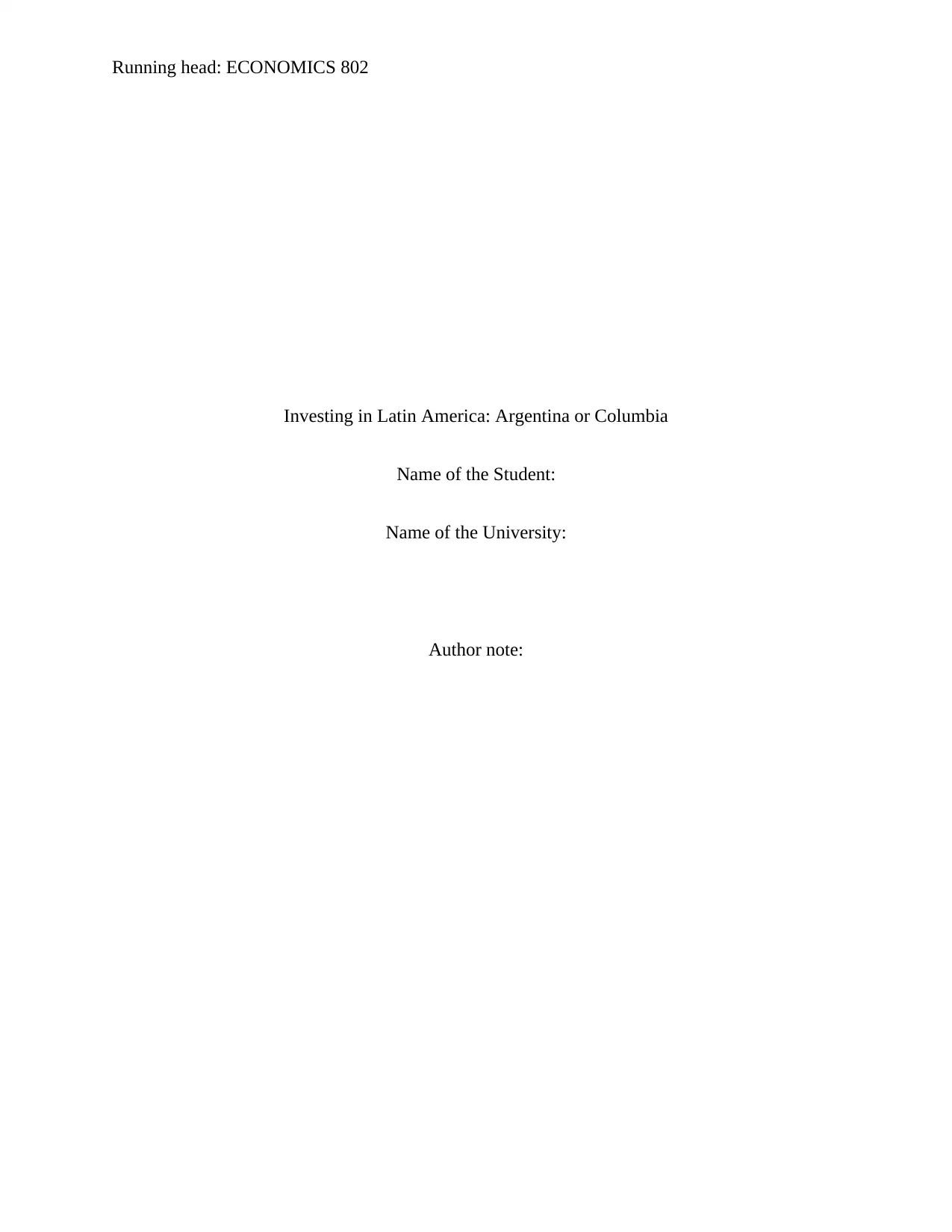
Running head: ECONOMICS 802
Investing in Latin America: Argentina or Columbia
Name of the Student:
Name of the University:
Author note:
Investing in Latin America: Argentina or Columbia
Name of the Student:
Name of the University:
Author note:
Paraphrase This Document
Need a fresh take? Get an instant paraphrase of this document with our AI Paraphraser
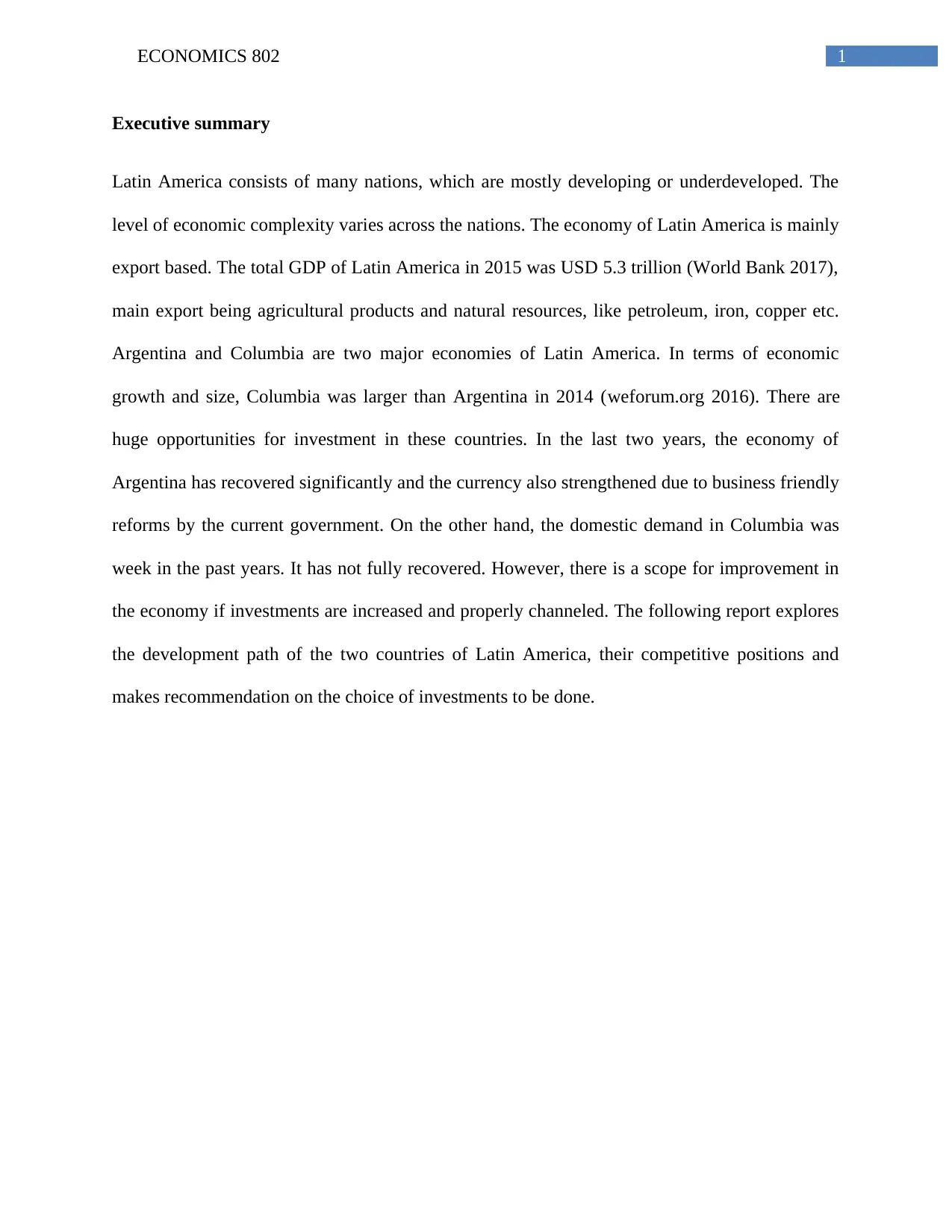
1ECONOMICS 802
Executive summary
Latin America consists of many nations, which are mostly developing or underdeveloped. The
level of economic complexity varies across the nations. The economy of Latin America is mainly
export based. The total GDP of Latin America in 2015 was USD 5.3 trillion (World Bank 2017),
main export being agricultural products and natural resources, like petroleum, iron, copper etc.
Argentina and Columbia are two major economies of Latin America. In terms of economic
growth and size, Columbia was larger than Argentina in 2014 (weforum.org 2016). There are
huge opportunities for investment in these countries. In the last two years, the economy of
Argentina has recovered significantly and the currency also strengthened due to business friendly
reforms by the current government. On the other hand, the domestic demand in Columbia was
week in the past years. It has not fully recovered. However, there is a scope for improvement in
the economy if investments are increased and properly channeled. The following report explores
the development path of the two countries of Latin America, their competitive positions and
makes recommendation on the choice of investments to be done.
Executive summary
Latin America consists of many nations, which are mostly developing or underdeveloped. The
level of economic complexity varies across the nations. The economy of Latin America is mainly
export based. The total GDP of Latin America in 2015 was USD 5.3 trillion (World Bank 2017),
main export being agricultural products and natural resources, like petroleum, iron, copper etc.
Argentina and Columbia are two major economies of Latin America. In terms of economic
growth and size, Columbia was larger than Argentina in 2014 (weforum.org 2016). There are
huge opportunities for investment in these countries. In the last two years, the economy of
Argentina has recovered significantly and the currency also strengthened due to business friendly
reforms by the current government. On the other hand, the domestic demand in Columbia was
week in the past years. It has not fully recovered. However, there is a scope for improvement in
the economy if investments are increased and properly channeled. The following report explores
the development path of the two countries of Latin America, their competitive positions and
makes recommendation on the choice of investments to be done.
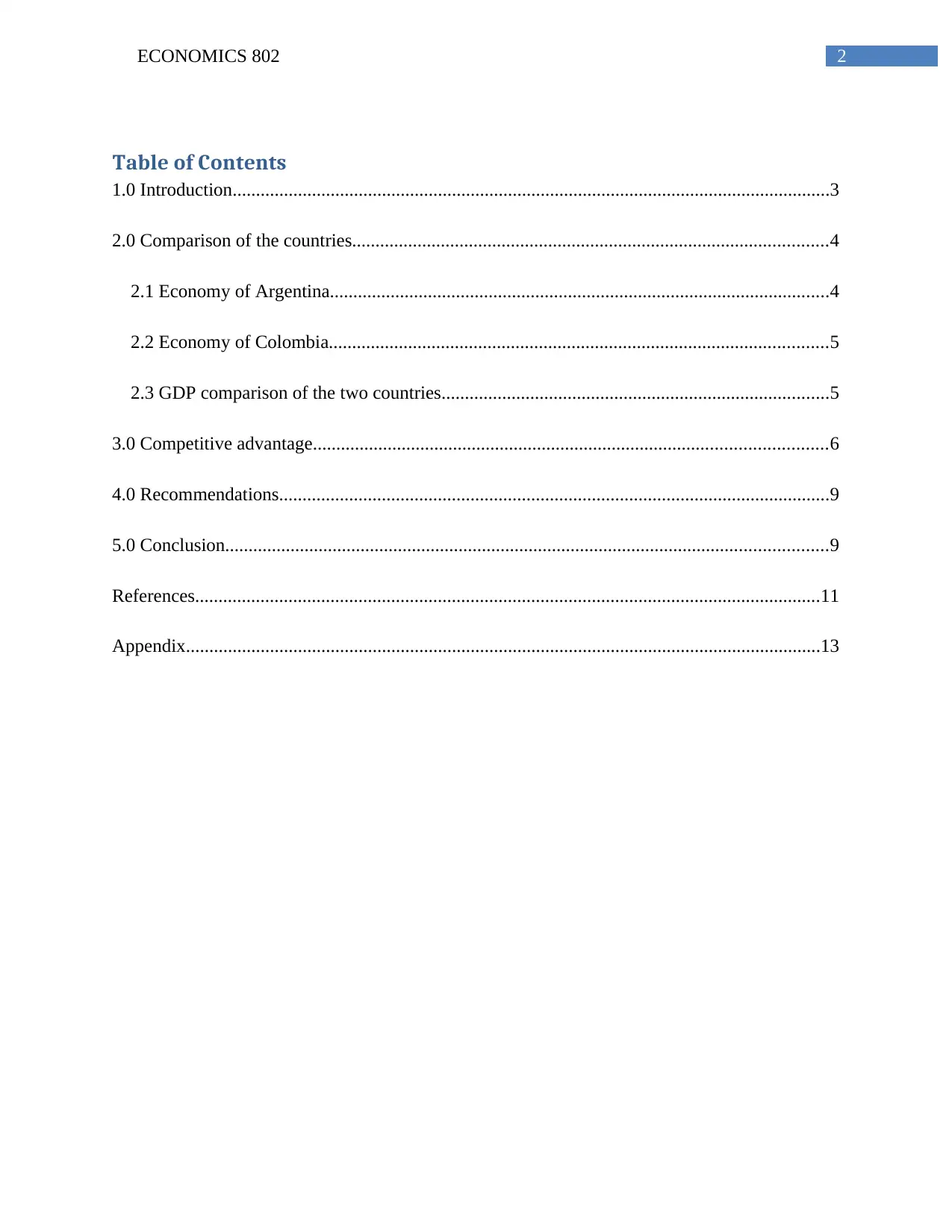
2ECONOMICS 802
Table of Contents
1.0 Introduction................................................................................................................................3
2.0 Comparison of the countries......................................................................................................4
2.1 Economy of Argentina...........................................................................................................4
2.2 Economy of Colombia...........................................................................................................5
2.3 GDP comparison of the two countries...................................................................................5
3.0 Competitive advantage..............................................................................................................6
4.0 Recommendations......................................................................................................................9
5.0 Conclusion.................................................................................................................................9
References......................................................................................................................................11
Appendix........................................................................................................................................13
Table of Contents
1.0 Introduction................................................................................................................................3
2.0 Comparison of the countries......................................................................................................4
2.1 Economy of Argentina...........................................................................................................4
2.2 Economy of Colombia...........................................................................................................5
2.3 GDP comparison of the two countries...................................................................................5
3.0 Competitive advantage..............................................................................................................6
4.0 Recommendations......................................................................................................................9
5.0 Conclusion.................................................................................................................................9
References......................................................................................................................................11
Appendix........................................................................................................................................13
⊘ This is a preview!⊘
Do you want full access?
Subscribe today to unlock all pages.

Trusted by 1+ million students worldwide
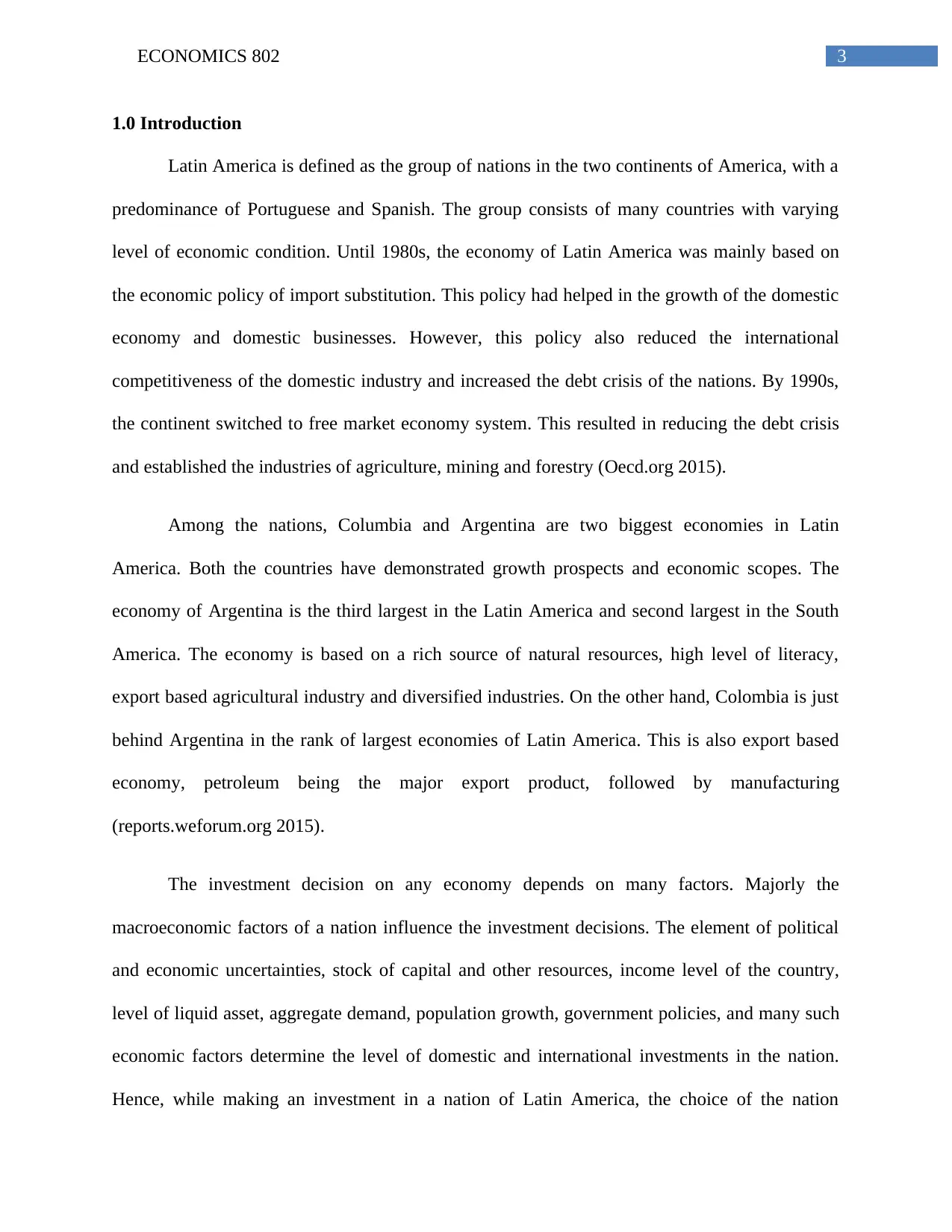
3ECONOMICS 802
1.0 Introduction
Latin America is defined as the group of nations in the two continents of America, with a
predominance of Portuguese and Spanish. The group consists of many countries with varying
level of economic condition. Until 1980s, the economy of Latin America was mainly based on
the economic policy of import substitution. This policy had helped in the growth of the domestic
economy and domestic businesses. However, this policy also reduced the international
competitiveness of the domestic industry and increased the debt crisis of the nations. By 1990s,
the continent switched to free market economy system. This resulted in reducing the debt crisis
and established the industries of agriculture, mining and forestry (Oecd.org 2015).
Among the nations, Columbia and Argentina are two biggest economies in Latin
America. Both the countries have demonstrated growth prospects and economic scopes. The
economy of Argentina is the third largest in the Latin America and second largest in the South
America. The economy is based on a rich source of natural resources, high level of literacy,
export based agricultural industry and diversified industries. On the other hand, Colombia is just
behind Argentina in the rank of largest economies of Latin America. This is also export based
economy, petroleum being the major export product, followed by manufacturing
(reports.weforum.org 2015).
The investment decision on any economy depends on many factors. Majorly the
macroeconomic factors of a nation influence the investment decisions. The element of political
and economic uncertainties, stock of capital and other resources, income level of the country,
level of liquid asset, aggregate demand, population growth, government policies, and many such
economic factors determine the level of domestic and international investments in the nation.
Hence, while making an investment in a nation of Latin America, the choice of the nation
1.0 Introduction
Latin America is defined as the group of nations in the two continents of America, with a
predominance of Portuguese and Spanish. The group consists of many countries with varying
level of economic condition. Until 1980s, the economy of Latin America was mainly based on
the economic policy of import substitution. This policy had helped in the growth of the domestic
economy and domestic businesses. However, this policy also reduced the international
competitiveness of the domestic industry and increased the debt crisis of the nations. By 1990s,
the continent switched to free market economy system. This resulted in reducing the debt crisis
and established the industries of agriculture, mining and forestry (Oecd.org 2015).
Among the nations, Columbia and Argentina are two biggest economies in Latin
America. Both the countries have demonstrated growth prospects and economic scopes. The
economy of Argentina is the third largest in the Latin America and second largest in the South
America. The economy is based on a rich source of natural resources, high level of literacy,
export based agricultural industry and diversified industries. On the other hand, Colombia is just
behind Argentina in the rank of largest economies of Latin America. This is also export based
economy, petroleum being the major export product, followed by manufacturing
(reports.weforum.org 2015).
The investment decision on any economy depends on many factors. Majorly the
macroeconomic factors of a nation influence the investment decisions. The element of political
and economic uncertainties, stock of capital and other resources, income level of the country,
level of liquid asset, aggregate demand, population growth, government policies, and many such
economic factors determine the level of domestic and international investments in the nation.
Hence, while making an investment in a nation of Latin America, the choice of the nation
Paraphrase This Document
Need a fresh take? Get an instant paraphrase of this document with our AI Paraphraser
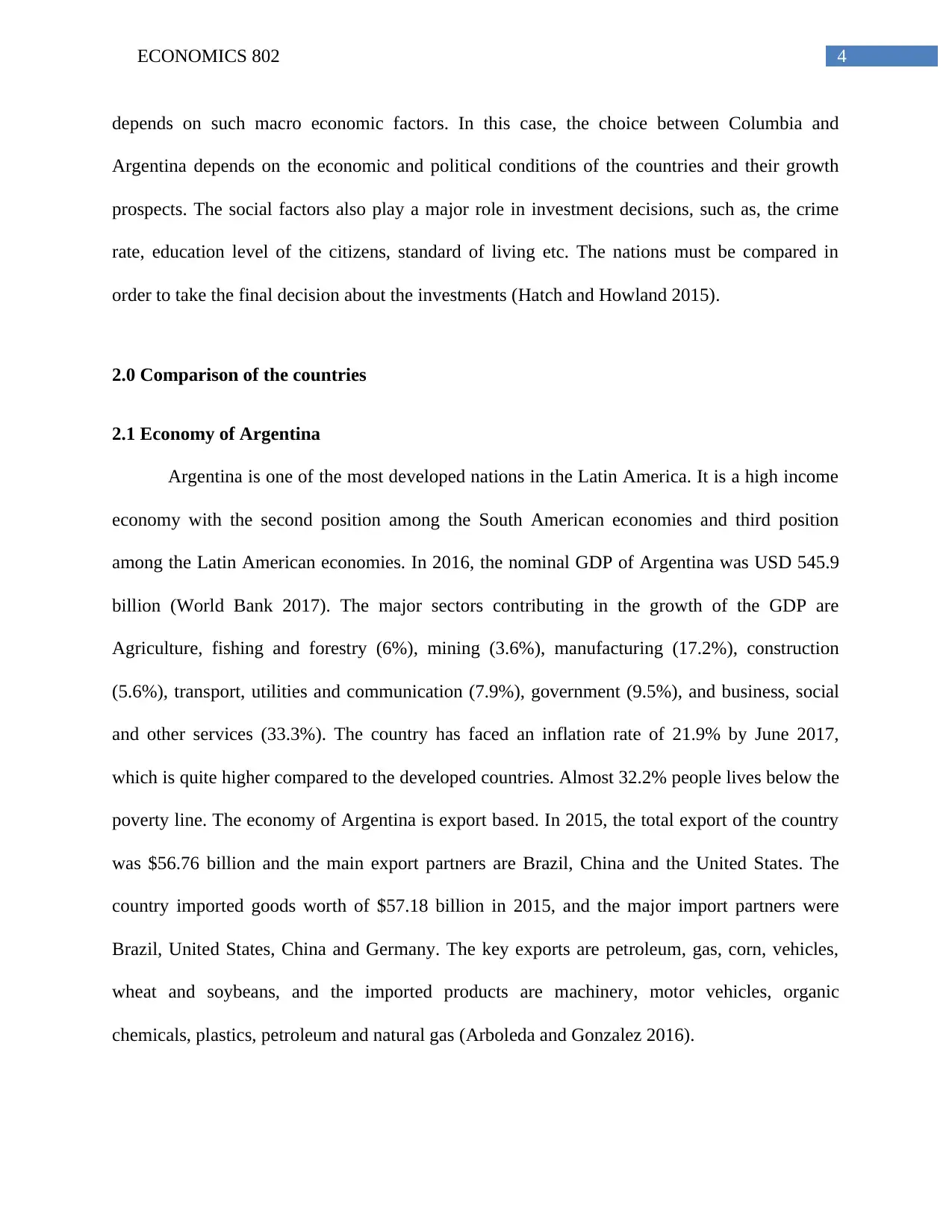
4ECONOMICS 802
depends on such macro economic factors. In this case, the choice between Columbia and
Argentina depends on the economic and political conditions of the countries and their growth
prospects. The social factors also play a major role in investment decisions, such as, the crime
rate, education level of the citizens, standard of living etc. The nations must be compared in
order to take the final decision about the investments (Hatch and Howland 2015).
2.0 Comparison of the countries
2.1 Economy of Argentina
Argentina is one of the most developed nations in the Latin America. It is a high income
economy with the second position among the South American economies and third position
among the Latin American economies. In 2016, the nominal GDP of Argentina was USD 545.9
billion (World Bank 2017). The major sectors contributing in the growth of the GDP are
Agriculture, fishing and forestry (6%), mining (3.6%), manufacturing (17.2%), construction
(5.6%), transport, utilities and communication (7.9%), government (9.5%), and business, social
and other services (33.3%). The country has faced an inflation rate of 21.9% by June 2017,
which is quite higher compared to the developed countries. Almost 32.2% people lives below the
poverty line. The economy of Argentina is export based. In 2015, the total export of the country
was $56.76 billion and the main export partners are Brazil, China and the United States. The
country imported goods worth of $57.18 billion in 2015, and the major import partners were
Brazil, United States, China and Germany. The key exports are petroleum, gas, corn, vehicles,
wheat and soybeans, and the imported products are machinery, motor vehicles, organic
chemicals, plastics, petroleum and natural gas (Arboleda and Gonzalez 2016).
depends on such macro economic factors. In this case, the choice between Columbia and
Argentina depends on the economic and political conditions of the countries and their growth
prospects. The social factors also play a major role in investment decisions, such as, the crime
rate, education level of the citizens, standard of living etc. The nations must be compared in
order to take the final decision about the investments (Hatch and Howland 2015).
2.0 Comparison of the countries
2.1 Economy of Argentina
Argentina is one of the most developed nations in the Latin America. It is a high income
economy with the second position among the South American economies and third position
among the Latin American economies. In 2016, the nominal GDP of Argentina was USD 545.9
billion (World Bank 2017). The major sectors contributing in the growth of the GDP are
Agriculture, fishing and forestry (6%), mining (3.6%), manufacturing (17.2%), construction
(5.6%), transport, utilities and communication (7.9%), government (9.5%), and business, social
and other services (33.3%). The country has faced an inflation rate of 21.9% by June 2017,
which is quite higher compared to the developed countries. Almost 32.2% people lives below the
poverty line. The economy of Argentina is export based. In 2015, the total export of the country
was $56.76 billion and the main export partners are Brazil, China and the United States. The
country imported goods worth of $57.18 billion in 2015, and the major import partners were
Brazil, United States, China and Germany. The key exports are petroleum, gas, corn, vehicles,
wheat and soybeans, and the imported products are machinery, motor vehicles, organic
chemicals, plastics, petroleum and natural gas (Arboleda and Gonzalez 2016).
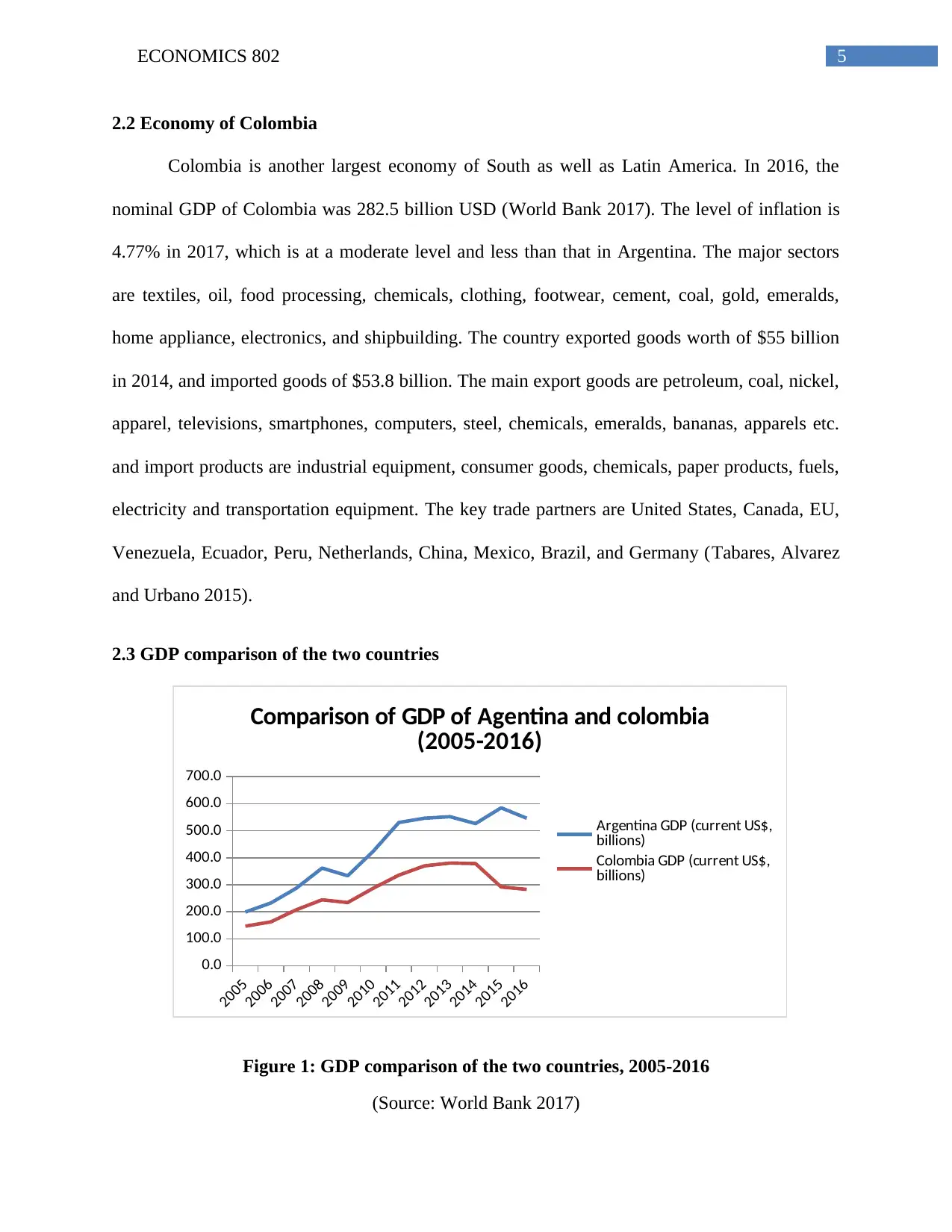
5ECONOMICS 802
2.2 Economy of Colombia
Colombia is another largest economy of South as well as Latin America. In 2016, the
nominal GDP of Colombia was 282.5 billion USD (World Bank 2017). The level of inflation is
4.77% in 2017, which is at a moderate level and less than that in Argentina. The major sectors
are textiles, oil, food processing, chemicals, clothing, footwear, cement, coal, gold, emeralds,
home appliance, electronics, and shipbuilding. The country exported goods worth of $55 billion
in 2014, and imported goods of $53.8 billion. The main export goods are petroleum, coal, nickel,
apparel, televisions, smartphones, computers, steel, chemicals, emeralds, bananas, apparels etc.
and import products are industrial equipment, consumer goods, chemicals, paper products, fuels,
electricity and transportation equipment. The key trade partners are United States, Canada, EU,
Venezuela, Ecuador, Peru, Netherlands, China, Mexico, Brazil, and Germany (Tabares, Alvarez
and Urbano 2015).
2.3 GDP comparison of the two countries
2005
2006
2007
2008
2009
2010
2011
2012
2013
2014
2015
2016
0.0
100.0
200.0
300.0
400.0
500.0
600.0
700.0
Comparison of GDP of Agentina and colombia
(2005-2016)
Argentina GDP (current US$,
billions)
Colombia GDP (current US$,
billions)
Figure 1: GDP comparison of the two countries, 2005-2016
(Source: World Bank 2017)
2.2 Economy of Colombia
Colombia is another largest economy of South as well as Latin America. In 2016, the
nominal GDP of Colombia was 282.5 billion USD (World Bank 2017). The level of inflation is
4.77% in 2017, which is at a moderate level and less than that in Argentina. The major sectors
are textiles, oil, food processing, chemicals, clothing, footwear, cement, coal, gold, emeralds,
home appliance, electronics, and shipbuilding. The country exported goods worth of $55 billion
in 2014, and imported goods of $53.8 billion. The main export goods are petroleum, coal, nickel,
apparel, televisions, smartphones, computers, steel, chemicals, emeralds, bananas, apparels etc.
and import products are industrial equipment, consumer goods, chemicals, paper products, fuels,
electricity and transportation equipment. The key trade partners are United States, Canada, EU,
Venezuela, Ecuador, Peru, Netherlands, China, Mexico, Brazil, and Germany (Tabares, Alvarez
and Urbano 2015).
2.3 GDP comparison of the two countries
2005
2006
2007
2008
2009
2010
2011
2012
2013
2014
2015
2016
0.0
100.0
200.0
300.0
400.0
500.0
600.0
700.0
Comparison of GDP of Agentina and colombia
(2005-2016)
Argentina GDP (current US$,
billions)
Colombia GDP (current US$,
billions)
Figure 1: GDP comparison of the two countries, 2005-2016
(Source: World Bank 2017)
⊘ This is a preview!⊘
Do you want full access?
Subscribe today to unlock all pages.

Trusted by 1+ million students worldwide
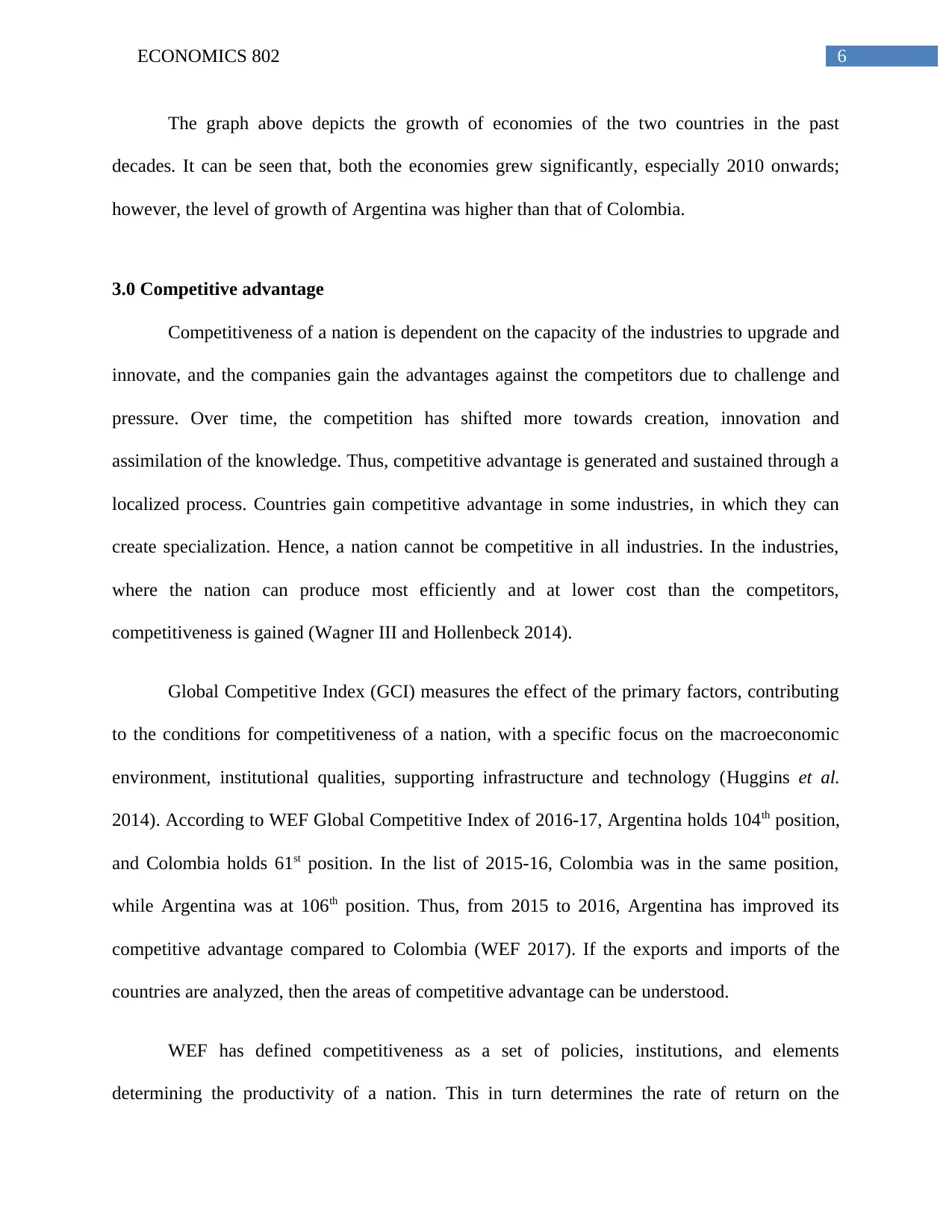
6ECONOMICS 802
The graph above depicts the growth of economies of the two countries in the past
decades. It can be seen that, both the economies grew significantly, especially 2010 onwards;
however, the level of growth of Argentina was higher than that of Colombia.
3.0 Competitive advantage
Competitiveness of a nation is dependent on the capacity of the industries to upgrade and
innovate, and the companies gain the advantages against the competitors due to challenge and
pressure. Over time, the competition has shifted more towards creation, innovation and
assimilation of the knowledge. Thus, competitive advantage is generated and sustained through a
localized process. Countries gain competitive advantage in some industries, in which they can
create specialization. Hence, a nation cannot be competitive in all industries. In the industries,
where the nation can produce most efficiently and at lower cost than the competitors,
competitiveness is gained (Wagner III and Hollenbeck 2014).
Global Competitive Index (GCI) measures the effect of the primary factors, contributing
to the conditions for competitiveness of a nation, with a specific focus on the macroeconomic
environment, institutional qualities, supporting infrastructure and technology (Huggins et al.
2014). According to WEF Global Competitive Index of 2016-17, Argentina holds 104th position,
and Colombia holds 61st position. In the list of 2015-16, Colombia was in the same position,
while Argentina was at 106th position. Thus, from 2015 to 2016, Argentina has improved its
competitive advantage compared to Colombia (WEF 2017). If the exports and imports of the
countries are analyzed, then the areas of competitive advantage can be understood.
WEF has defined competitiveness as a set of policies, institutions, and elements
determining the productivity of a nation. This in turn determines the rate of return on the
The graph above depicts the growth of economies of the two countries in the past
decades. It can be seen that, both the economies grew significantly, especially 2010 onwards;
however, the level of growth of Argentina was higher than that of Colombia.
3.0 Competitive advantage
Competitiveness of a nation is dependent on the capacity of the industries to upgrade and
innovate, and the companies gain the advantages against the competitors due to challenge and
pressure. Over time, the competition has shifted more towards creation, innovation and
assimilation of the knowledge. Thus, competitive advantage is generated and sustained through a
localized process. Countries gain competitive advantage in some industries, in which they can
create specialization. Hence, a nation cannot be competitive in all industries. In the industries,
where the nation can produce most efficiently and at lower cost than the competitors,
competitiveness is gained (Wagner III and Hollenbeck 2014).
Global Competitive Index (GCI) measures the effect of the primary factors, contributing
to the conditions for competitiveness of a nation, with a specific focus on the macroeconomic
environment, institutional qualities, supporting infrastructure and technology (Huggins et al.
2014). According to WEF Global Competitive Index of 2016-17, Argentina holds 104th position,
and Colombia holds 61st position. In the list of 2015-16, Colombia was in the same position,
while Argentina was at 106th position. Thus, from 2015 to 2016, Argentina has improved its
competitive advantage compared to Colombia (WEF 2017). If the exports and imports of the
countries are analyzed, then the areas of competitive advantage can be understood.
WEF has defined competitiveness as a set of policies, institutions, and elements
determining the productivity of a nation. This in turn determines the rate of return on the
Paraphrase This Document
Need a fresh take? Get an instant paraphrase of this document with our AI Paraphraser
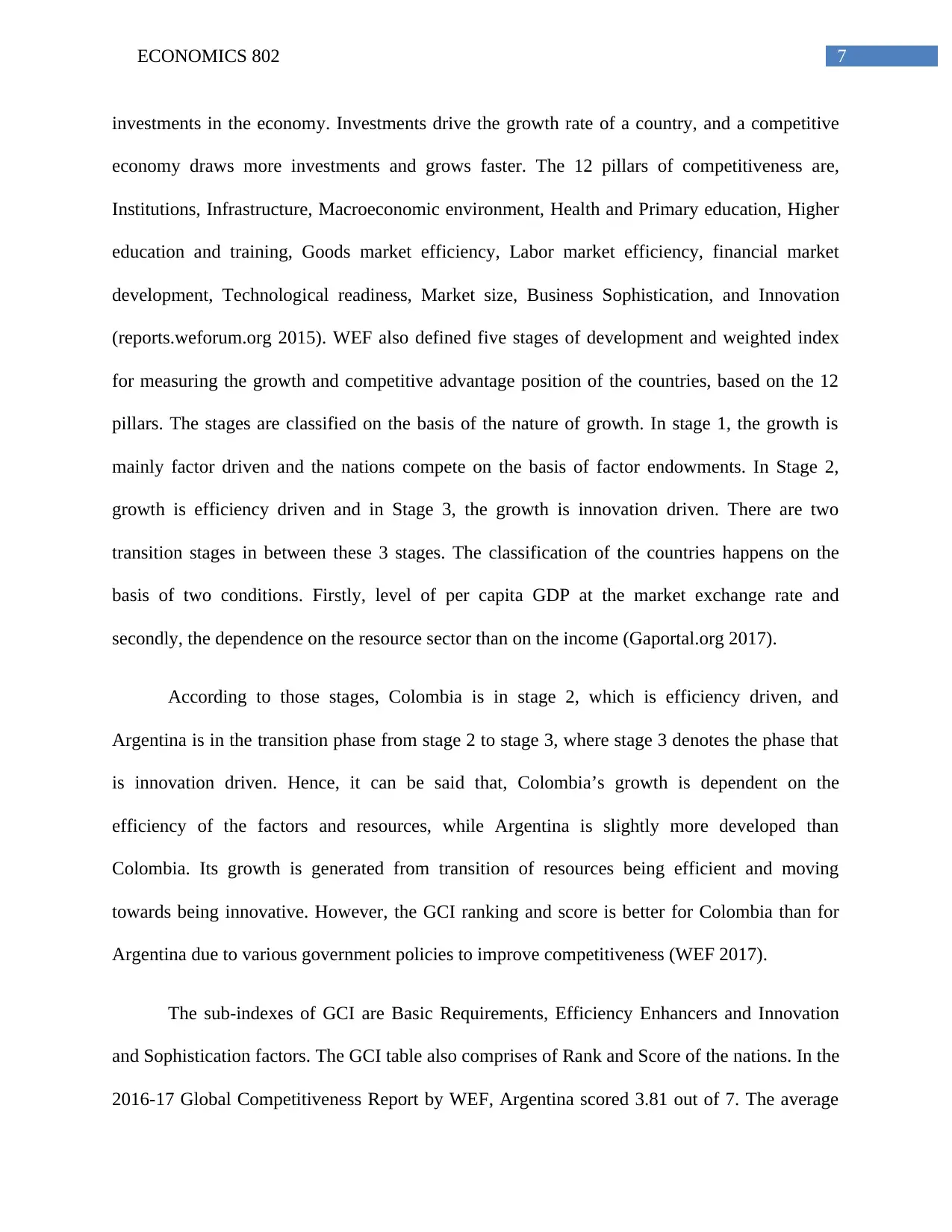
7ECONOMICS 802
investments in the economy. Investments drive the growth rate of a country, and a competitive
economy draws more investments and grows faster. The 12 pillars of competitiveness are,
Institutions, Infrastructure, Macroeconomic environment, Health and Primary education, Higher
education and training, Goods market efficiency, Labor market efficiency, financial market
development, Technological readiness, Market size, Business Sophistication, and Innovation
(reports.weforum.org 2015). WEF also defined five stages of development and weighted index
for measuring the growth and competitive advantage position of the countries, based on the 12
pillars. The stages are classified on the basis of the nature of growth. In stage 1, the growth is
mainly factor driven and the nations compete on the basis of factor endowments. In Stage 2,
growth is efficiency driven and in Stage 3, the growth is innovation driven. There are two
transition stages in between these 3 stages. The classification of the countries happens on the
basis of two conditions. Firstly, level of per capita GDP at the market exchange rate and
secondly, the dependence on the resource sector than on the income (Gaportal.org 2017).
According to those stages, Colombia is in stage 2, which is efficiency driven, and
Argentina is in the transition phase from stage 2 to stage 3, where stage 3 denotes the phase that
is innovation driven. Hence, it can be said that, Colombia’s growth is dependent on the
efficiency of the factors and resources, while Argentina is slightly more developed than
Colombia. Its growth is generated from transition of resources being efficient and moving
towards being innovative. However, the GCI ranking and score is better for Colombia than for
Argentina due to various government policies to improve competitiveness (WEF 2017).
The sub-indexes of GCI are Basic Requirements, Efficiency Enhancers and Innovation
and Sophistication factors. The GCI table also comprises of Rank and Score of the nations. In the
2016-17 Global Competitiveness Report by WEF, Argentina scored 3.81 out of 7. The average
investments in the economy. Investments drive the growth rate of a country, and a competitive
economy draws more investments and grows faster. The 12 pillars of competitiveness are,
Institutions, Infrastructure, Macroeconomic environment, Health and Primary education, Higher
education and training, Goods market efficiency, Labor market efficiency, financial market
development, Technological readiness, Market size, Business Sophistication, and Innovation
(reports.weforum.org 2015). WEF also defined five stages of development and weighted index
for measuring the growth and competitive advantage position of the countries, based on the 12
pillars. The stages are classified on the basis of the nature of growth. In stage 1, the growth is
mainly factor driven and the nations compete on the basis of factor endowments. In Stage 2,
growth is efficiency driven and in Stage 3, the growth is innovation driven. There are two
transition stages in between these 3 stages. The classification of the countries happens on the
basis of two conditions. Firstly, level of per capita GDP at the market exchange rate and
secondly, the dependence on the resource sector than on the income (Gaportal.org 2017).
According to those stages, Colombia is in stage 2, which is efficiency driven, and
Argentina is in the transition phase from stage 2 to stage 3, where stage 3 denotes the phase that
is innovation driven. Hence, it can be said that, Colombia’s growth is dependent on the
efficiency of the factors and resources, while Argentina is slightly more developed than
Colombia. Its growth is generated from transition of resources being efficient and moving
towards being innovative. However, the GCI ranking and score is better for Colombia than for
Argentina due to various government policies to improve competitiveness (WEF 2017).
The sub-indexes of GCI are Basic Requirements, Efficiency Enhancers and Innovation
and Sophistication factors. The GCI table also comprises of Rank and Score of the nations. In the
2016-17 Global Competitiveness Report by WEF, Argentina scored 3.81 out of 7. The average
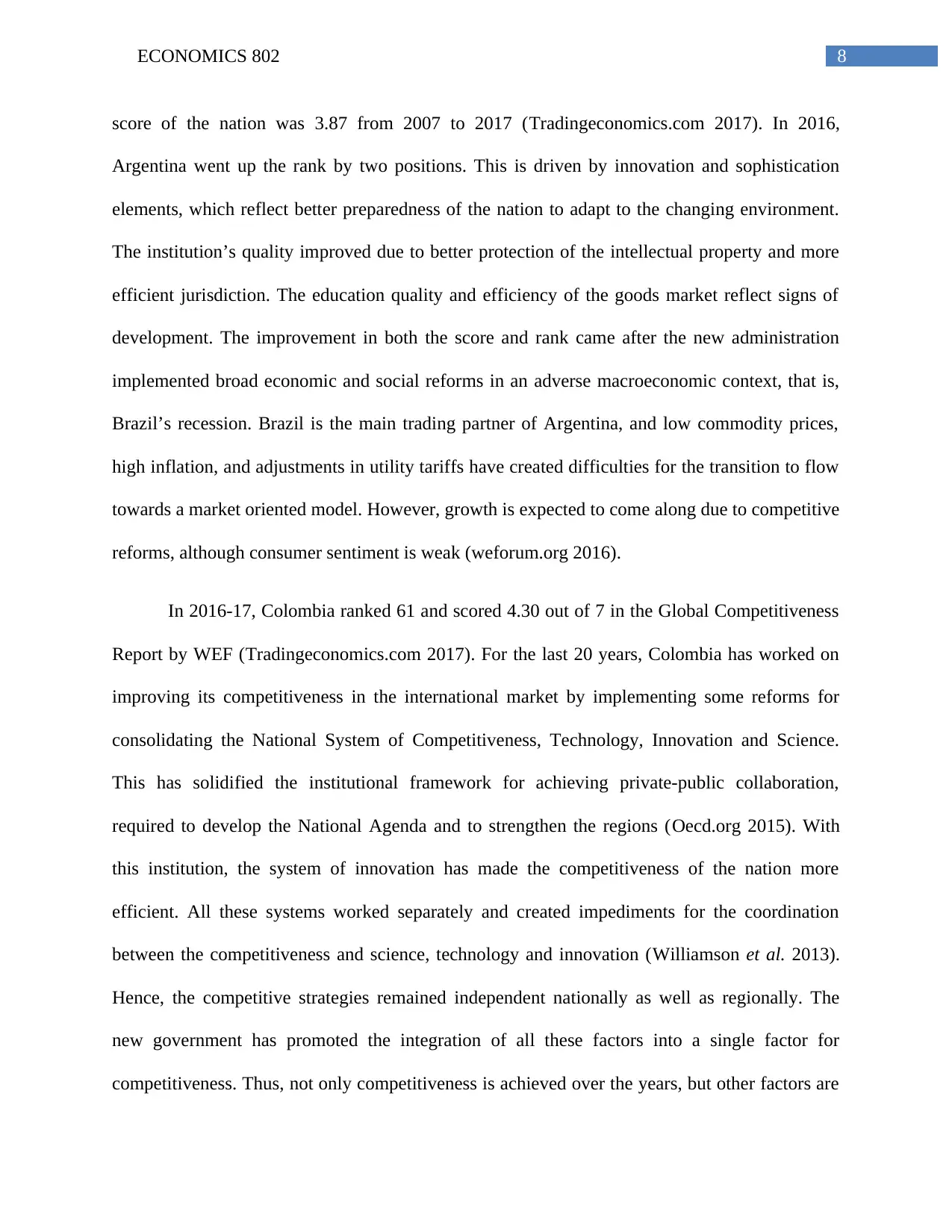
8ECONOMICS 802
score of the nation was 3.87 from 2007 to 2017 (Tradingeconomics.com 2017). In 2016,
Argentina went up the rank by two positions. This is driven by innovation and sophistication
elements, which reflect better preparedness of the nation to adapt to the changing environment.
The institution’s quality improved due to better protection of the intellectual property and more
efficient jurisdiction. The education quality and efficiency of the goods market reflect signs of
development. The improvement in both the score and rank came after the new administration
implemented broad economic and social reforms in an adverse macroeconomic context, that is,
Brazil’s recession. Brazil is the main trading partner of Argentina, and low commodity prices,
high inflation, and adjustments in utility tariffs have created difficulties for the transition to flow
towards a market oriented model. However, growth is expected to come along due to competitive
reforms, although consumer sentiment is weak (weforum.org 2016).
In 2016-17, Colombia ranked 61 and scored 4.30 out of 7 in the Global Competitiveness
Report by WEF (Tradingeconomics.com 2017). For the last 20 years, Colombia has worked on
improving its competitiveness in the international market by implementing some reforms for
consolidating the National System of Competitiveness, Technology, Innovation and Science.
This has solidified the institutional framework for achieving private-public collaboration,
required to develop the National Agenda and to strengthen the regions (Oecd.org 2015). With
this institution, the system of innovation has made the competitiveness of the nation more
efficient. All these systems worked separately and created impediments for the coordination
between the competitiveness and science, technology and innovation (Williamson et al. 2013).
Hence, the competitive strategies remained independent nationally as well as regionally. The
new government has promoted the integration of all these factors into a single factor for
competitiveness. Thus, not only competitiveness is achieved over the years, but other factors are
score of the nation was 3.87 from 2007 to 2017 (Tradingeconomics.com 2017). In 2016,
Argentina went up the rank by two positions. This is driven by innovation and sophistication
elements, which reflect better preparedness of the nation to adapt to the changing environment.
The institution’s quality improved due to better protection of the intellectual property and more
efficient jurisdiction. The education quality and efficiency of the goods market reflect signs of
development. The improvement in both the score and rank came after the new administration
implemented broad economic and social reforms in an adverse macroeconomic context, that is,
Brazil’s recession. Brazil is the main trading partner of Argentina, and low commodity prices,
high inflation, and adjustments in utility tariffs have created difficulties for the transition to flow
towards a market oriented model. However, growth is expected to come along due to competitive
reforms, although consumer sentiment is weak (weforum.org 2016).
In 2016-17, Colombia ranked 61 and scored 4.30 out of 7 in the Global Competitiveness
Report by WEF (Tradingeconomics.com 2017). For the last 20 years, Colombia has worked on
improving its competitiveness in the international market by implementing some reforms for
consolidating the National System of Competitiveness, Technology, Innovation and Science.
This has solidified the institutional framework for achieving private-public collaboration,
required to develop the National Agenda and to strengthen the regions (Oecd.org 2015). With
this institution, the system of innovation has made the competitiveness of the nation more
efficient. All these systems worked separately and created impediments for the coordination
between the competitiveness and science, technology and innovation (Williamson et al. 2013).
Hence, the competitive strategies remained independent nationally as well as regionally. The
new government has promoted the integration of all these factors into a single factor for
competitiveness. Thus, not only competitiveness is achieved over the years, but other factors are
⊘ This is a preview!⊘
Do you want full access?
Subscribe today to unlock all pages.

Trusted by 1+ million students worldwide
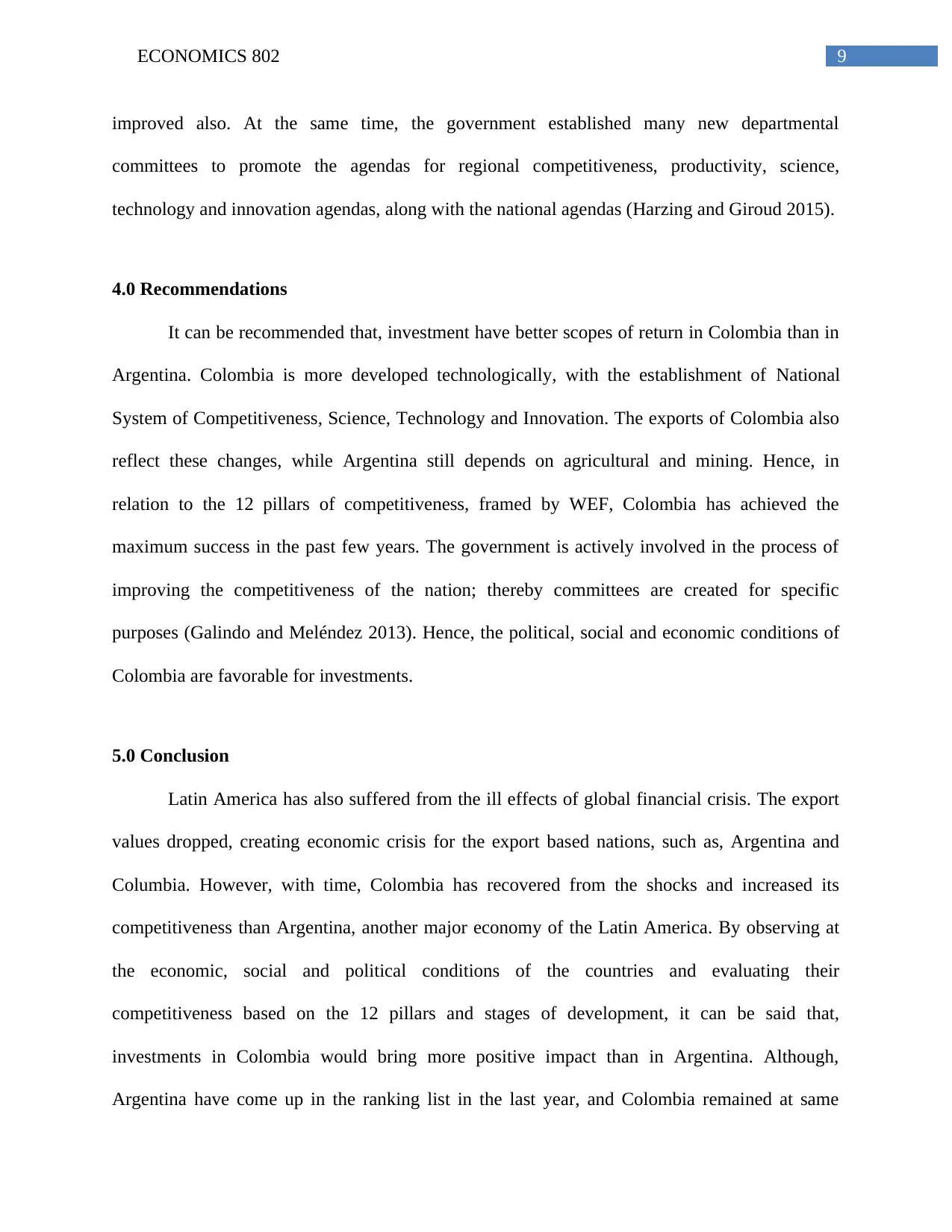
9ECONOMICS 802
improved also. At the same time, the government established many new departmental
committees to promote the agendas for regional competitiveness, productivity, science,
technology and innovation agendas, along with the national agendas (Harzing and Giroud 2015).
4.0 Recommendations
It can be recommended that, investment have better scopes of return in Colombia than in
Argentina. Colombia is more developed technologically, with the establishment of National
System of Competitiveness, Science, Technology and Innovation. The exports of Colombia also
reflect these changes, while Argentina still depends on agricultural and mining. Hence, in
relation to the 12 pillars of competitiveness, framed by WEF, Colombia has achieved the
maximum success in the past few years. The government is actively involved in the process of
improving the competitiveness of the nation; thereby committees are created for specific
purposes (Galindo and Meléndez 2013). Hence, the political, social and economic conditions of
Colombia are favorable for investments.
5.0 Conclusion
Latin America has also suffered from the ill effects of global financial crisis. The export
values dropped, creating economic crisis for the export based nations, such as, Argentina and
Columbia. However, with time, Colombia has recovered from the shocks and increased its
competitiveness than Argentina, another major economy of the Latin America. By observing at
the economic, social and political conditions of the countries and evaluating their
competitiveness based on the 12 pillars and stages of development, it can be said that,
investments in Colombia would bring more positive impact than in Argentina. Although,
Argentina have come up in the ranking list in the last year, and Colombia remained at same
improved also. At the same time, the government established many new departmental
committees to promote the agendas for regional competitiveness, productivity, science,
technology and innovation agendas, along with the national agendas (Harzing and Giroud 2015).
4.0 Recommendations
It can be recommended that, investment have better scopes of return in Colombia than in
Argentina. Colombia is more developed technologically, with the establishment of National
System of Competitiveness, Science, Technology and Innovation. The exports of Colombia also
reflect these changes, while Argentina still depends on agricultural and mining. Hence, in
relation to the 12 pillars of competitiveness, framed by WEF, Colombia has achieved the
maximum success in the past few years. The government is actively involved in the process of
improving the competitiveness of the nation; thereby committees are created for specific
purposes (Galindo and Meléndez 2013). Hence, the political, social and economic conditions of
Colombia are favorable for investments.
5.0 Conclusion
Latin America has also suffered from the ill effects of global financial crisis. The export
values dropped, creating economic crisis for the export based nations, such as, Argentina and
Columbia. However, with time, Colombia has recovered from the shocks and increased its
competitiveness than Argentina, another major economy of the Latin America. By observing at
the economic, social and political conditions of the countries and evaluating their
competitiveness based on the 12 pillars and stages of development, it can be said that,
investments in Colombia would bring more positive impact than in Argentina. Although,
Argentina have come up in the ranking list in the last year, and Colombia remained at same
Paraphrase This Document
Need a fresh take? Get an instant paraphrase of this document with our AI Paraphraser
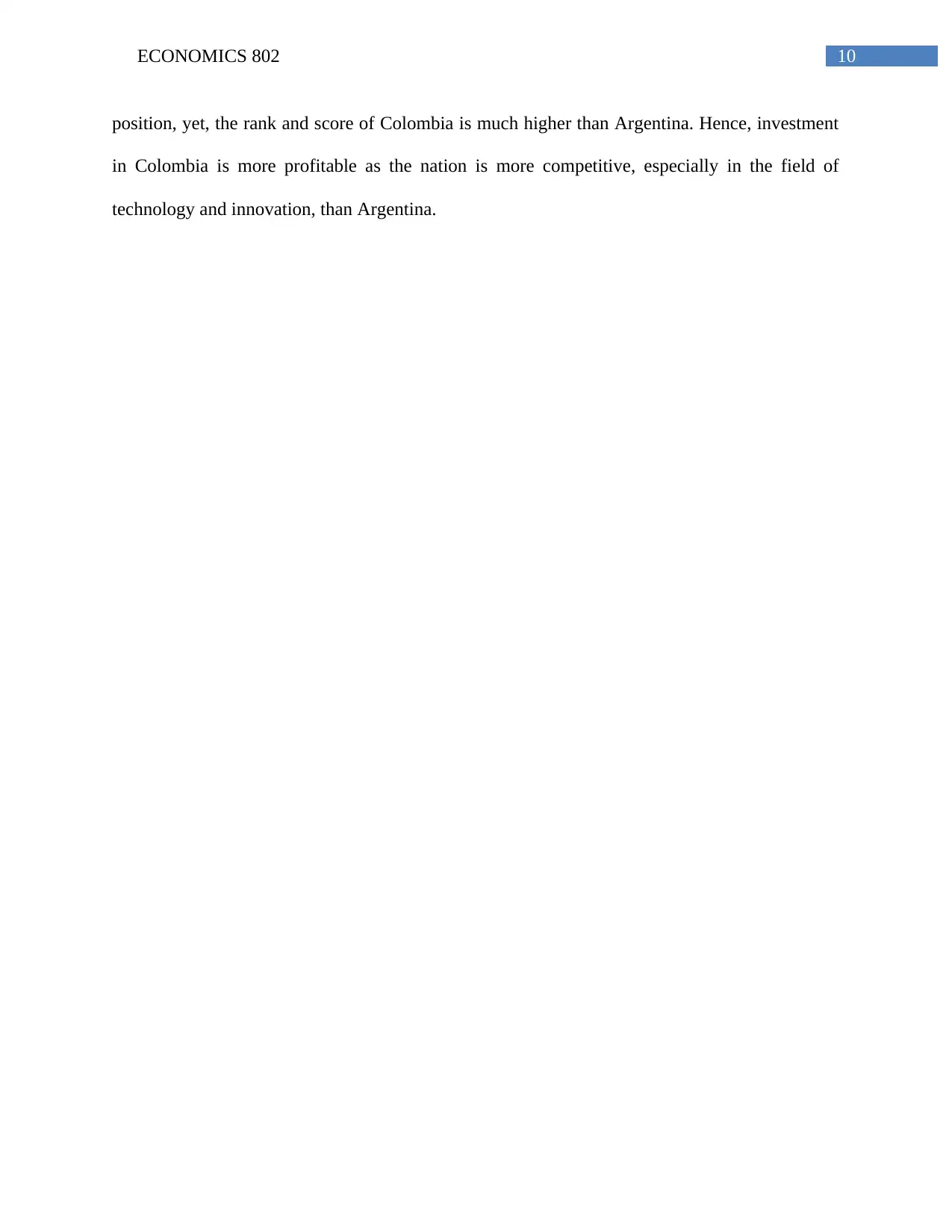
10ECONOMICS 802
position, yet, the rank and score of Colombia is much higher than Argentina. Hence, investment
in Colombia is more profitable as the nation is more competitive, especially in the field of
technology and innovation, than Argentina.
position, yet, the rank and score of Colombia is much higher than Argentina. Hence, investment
in Colombia is more profitable as the nation is more competitive, especially in the field of
technology and innovation, than Argentina.
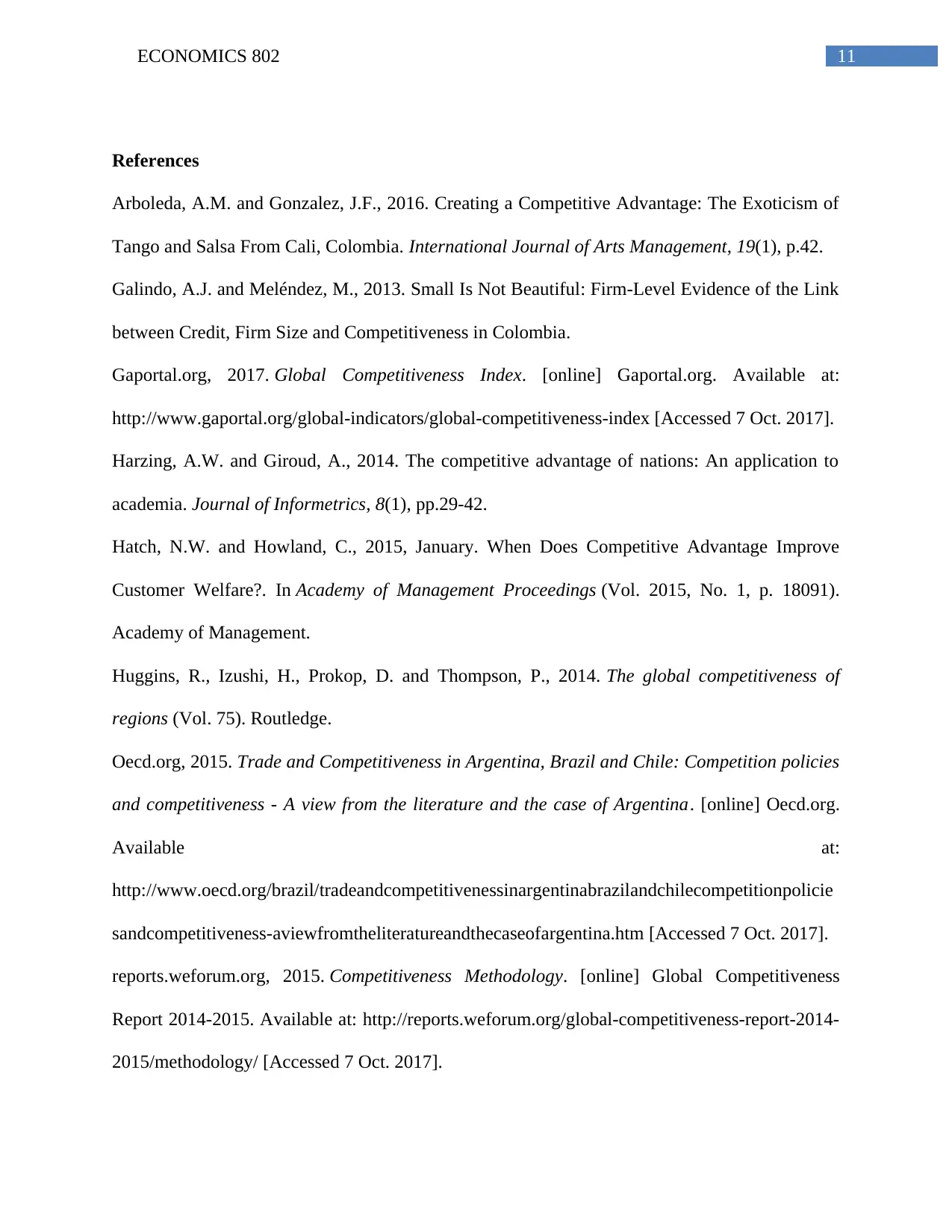
11ECONOMICS 802
References
Arboleda, A.M. and Gonzalez, J.F., 2016. Creating a Competitive Advantage: The Exoticism of
Tango and Salsa From Cali, Colombia. International Journal of Arts Management, 19(1), p.42.
Galindo, A.J. and Meléndez, M., 2013. Small Is Not Beautiful: Firm-Level Evidence of the Link
between Credit, Firm Size and Competitiveness in Colombia.
Gaportal.org, 2017. Global Competitiveness Index. [online] Gaportal.org. Available at:
http://www.gaportal.org/global-indicators/global-competitiveness-index [Accessed 7 Oct. 2017].
Harzing, A.W. and Giroud, A., 2014. The competitive advantage of nations: An application to
academia. Journal of Informetrics, 8(1), pp.29-42.
Hatch, N.W. and Howland, C., 2015, January. When Does Competitive Advantage Improve
Customer Welfare?. In Academy of Management Proceedings (Vol. 2015, No. 1, p. 18091).
Academy of Management.
Huggins, R., Izushi, H., Prokop, D. and Thompson, P., 2014. The global competitiveness of
regions (Vol. 75). Routledge.
Oecd.org, 2015. Trade and Competitiveness in Argentina, Brazil and Chile: Competition policies
and competitiveness - A view from the literature and the case of Argentina. [online] Oecd.org.
Available at:
http://www.oecd.org/brazil/tradeandcompetitivenessinargentinabrazilandchilecompetitionpolicie
sandcompetitiveness-aviewfromtheliteratureandthecaseofargentina.htm [Accessed 7 Oct. 2017].
reports.weforum.org, 2015. Competitiveness Methodology. [online] Global Competitiveness
Report 2014-2015. Available at: http://reports.weforum.org/global-competitiveness-report-2014-
2015/methodology/ [Accessed 7 Oct. 2017].
References
Arboleda, A.M. and Gonzalez, J.F., 2016. Creating a Competitive Advantage: The Exoticism of
Tango and Salsa From Cali, Colombia. International Journal of Arts Management, 19(1), p.42.
Galindo, A.J. and Meléndez, M., 2013. Small Is Not Beautiful: Firm-Level Evidence of the Link
between Credit, Firm Size and Competitiveness in Colombia.
Gaportal.org, 2017. Global Competitiveness Index. [online] Gaportal.org. Available at:
http://www.gaportal.org/global-indicators/global-competitiveness-index [Accessed 7 Oct. 2017].
Harzing, A.W. and Giroud, A., 2014. The competitive advantage of nations: An application to
academia. Journal of Informetrics, 8(1), pp.29-42.
Hatch, N.W. and Howland, C., 2015, January. When Does Competitive Advantage Improve
Customer Welfare?. In Academy of Management Proceedings (Vol. 2015, No. 1, p. 18091).
Academy of Management.
Huggins, R., Izushi, H., Prokop, D. and Thompson, P., 2014. The global competitiveness of
regions (Vol. 75). Routledge.
Oecd.org, 2015. Trade and Competitiveness in Argentina, Brazil and Chile: Competition policies
and competitiveness - A view from the literature and the case of Argentina. [online] Oecd.org.
Available at:
http://www.oecd.org/brazil/tradeandcompetitivenessinargentinabrazilandchilecompetitionpolicie
sandcompetitiveness-aviewfromtheliteratureandthecaseofargentina.htm [Accessed 7 Oct. 2017].
reports.weforum.org, 2015. Competitiveness Methodology. [online] Global Competitiveness
Report 2014-2015. Available at: http://reports.weforum.org/global-competitiveness-report-2014-
2015/methodology/ [Accessed 7 Oct. 2017].
⊘ This is a preview!⊘
Do you want full access?
Subscribe today to unlock all pages.

Trusted by 1+ million students worldwide
1 out of 16
Related Documents
Your All-in-One AI-Powered Toolkit for Academic Success.
+13062052269
info@desklib.com
Available 24*7 on WhatsApp / Email
![[object Object]](/_next/static/media/star-bottom.7253800d.svg)
Unlock your academic potential
Copyright © 2020–2025 A2Z Services. All Rights Reserved. Developed and managed by ZUCOL.





